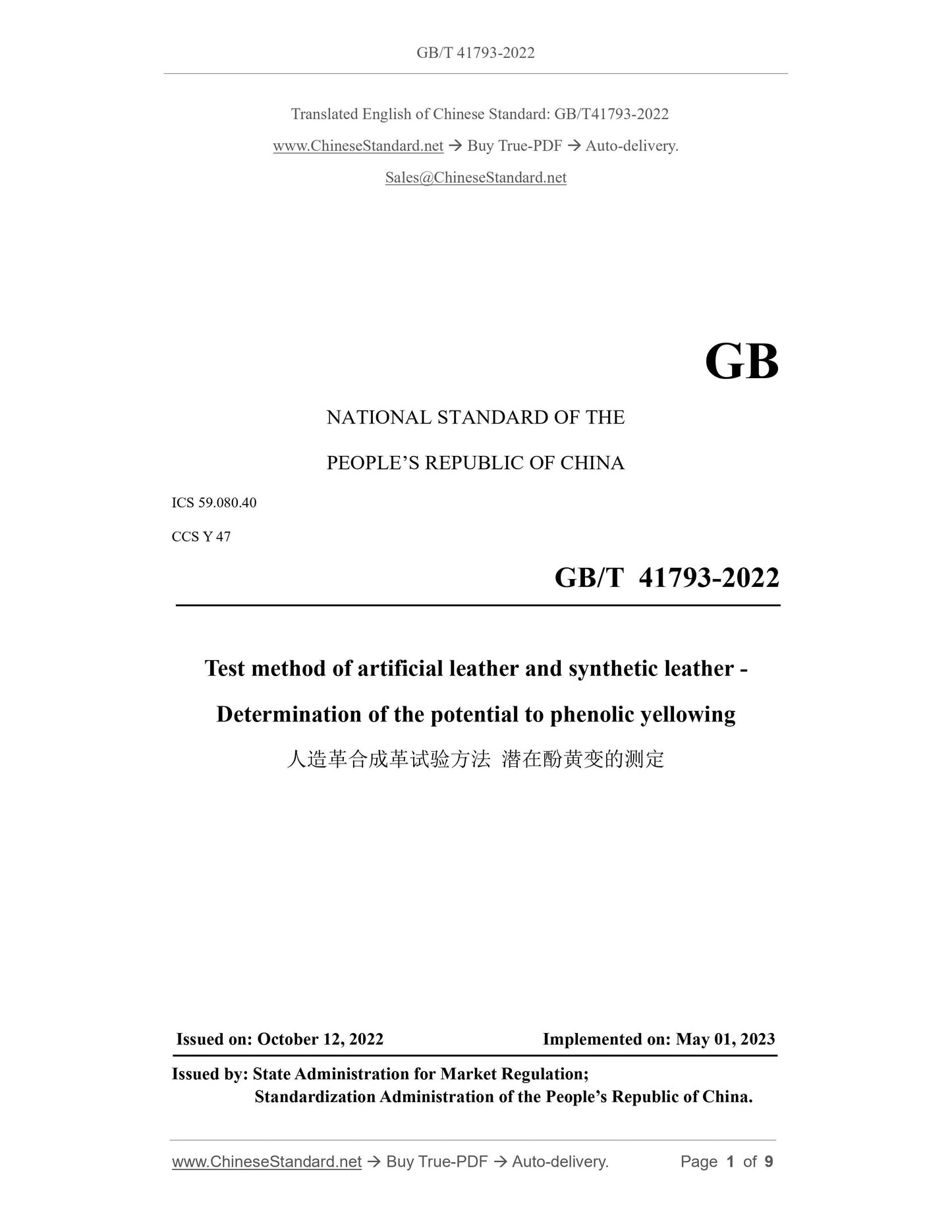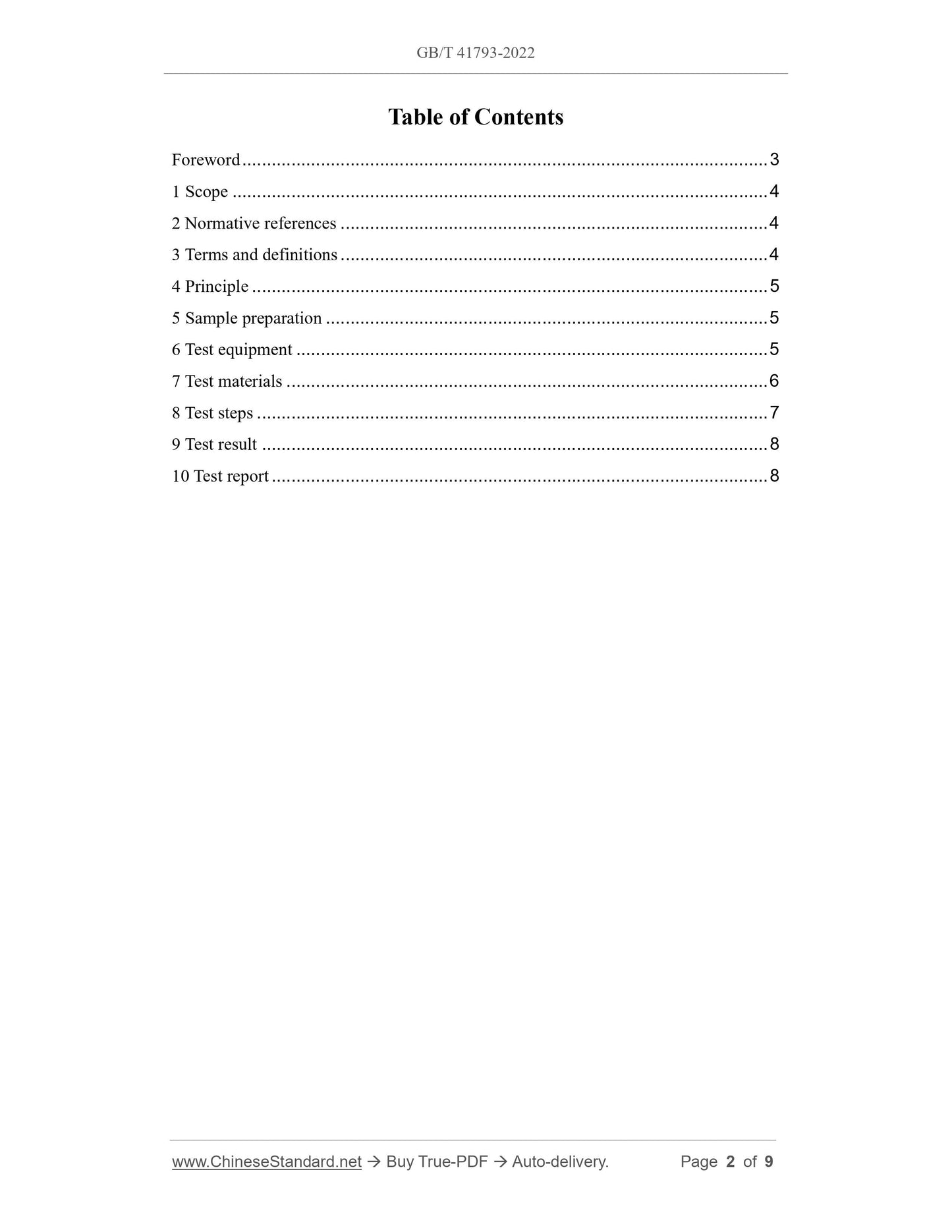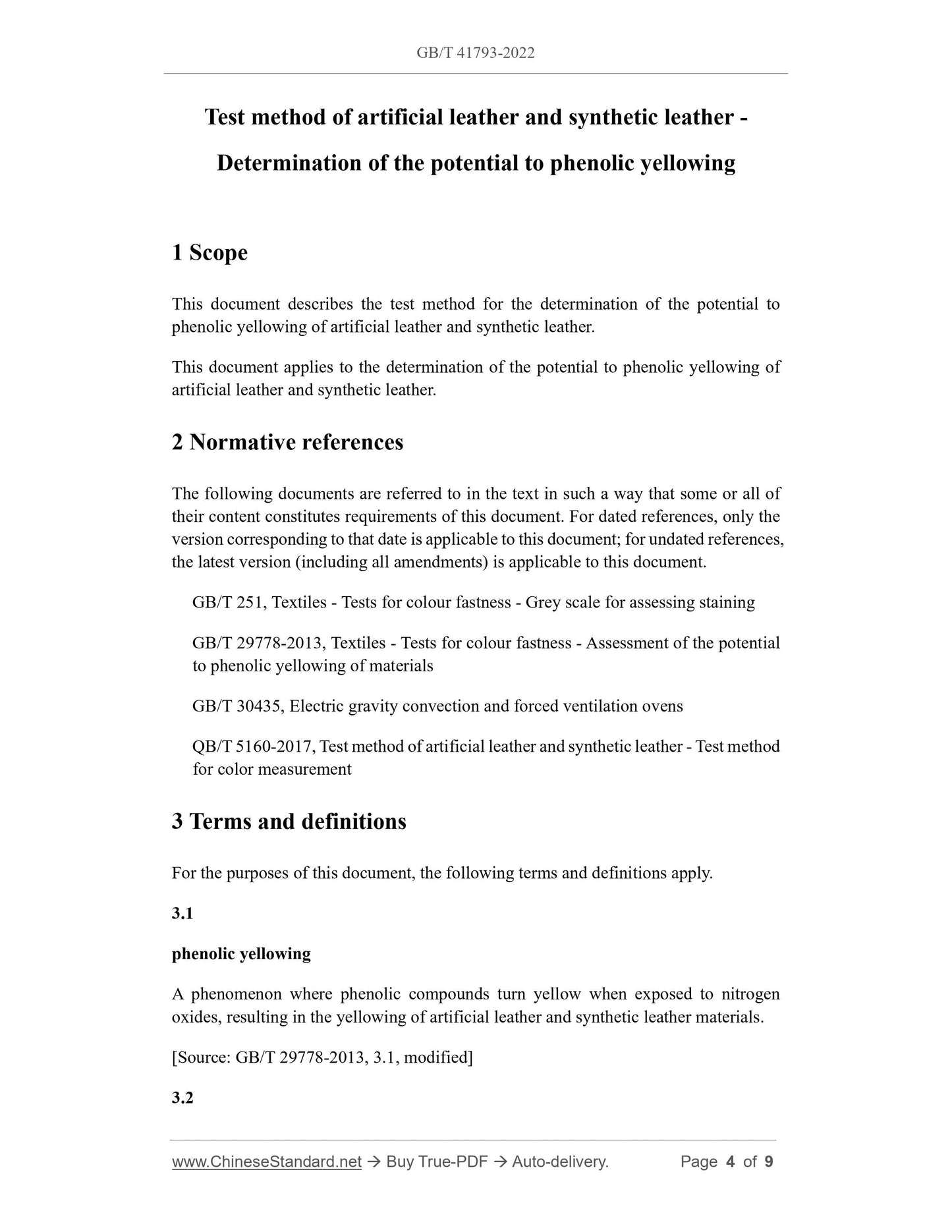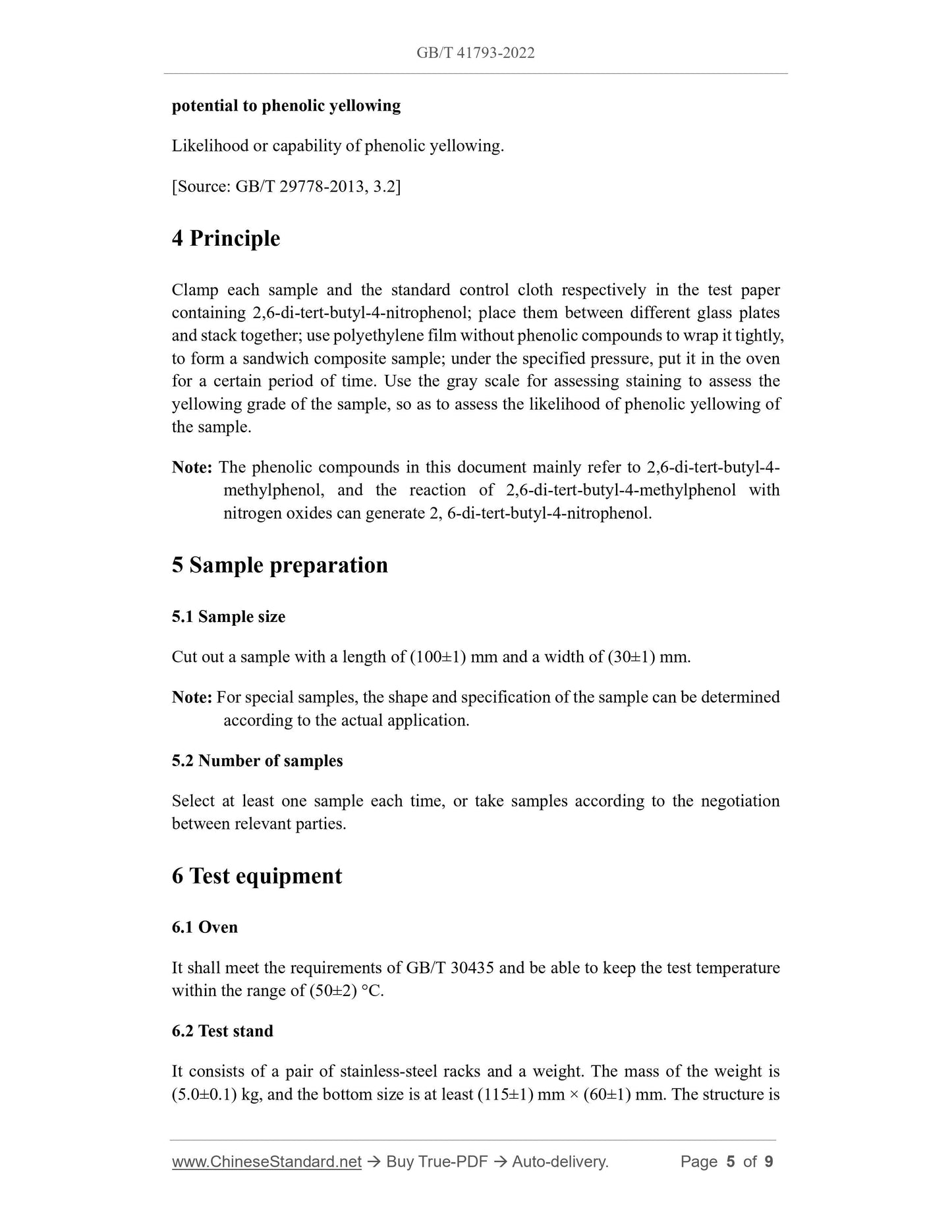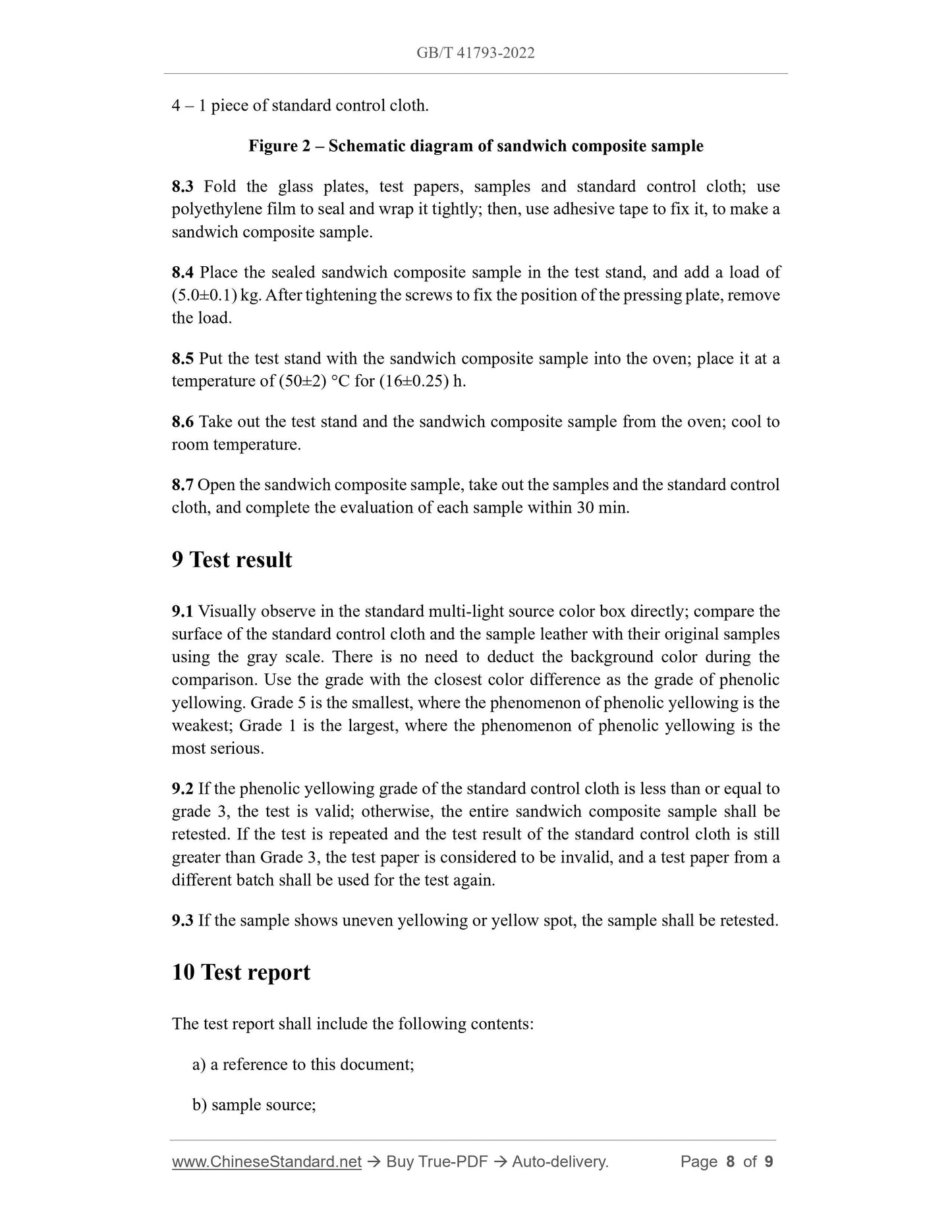1
/
of
5
PayPal, credit cards. Download editable-PDF & invoice in 1 second!
GB/T 41793-2022 English PDF (GBT41793-2022)
GB/T 41793-2022 English PDF (GBT41793-2022)
Regular price
$170.00 USD
Regular price
Sale price
$170.00 USD
Unit price
/
per
Shipping calculated at checkout.
Couldn't load pickup availability
Delivery: 3 seconds. Download true-PDF + Invoice.
Get QUOTATION in 1-minute: Click GB/T 41793-2022
Historical versions: GB/T 41793-2022
Preview True-PDF (Reload/Scroll if blank)
GB/T 41793-2022: Test method of artificial leather and synthetic leather - Determination of the potential to phenolic yellowing
GB/T 41793-2022
GB
NATIONAL STANDARD OF THE
PEOPLE’S REPUBLIC OF CHINA
ICS 59.080.40
CCS Y 47
Test method of artificial leather and synthetic leather -
Determination of the potential to phenolic yellowing
ISSUED ON: OCTOBER 12, 2022
IMPLEMENTED ON: MAY 01, 2023
Issued by: State Administration for Market Regulation;
Standardization Administration of the People’s Republic of China.
Table of Contents
Foreword ... 3
1 Scope ... 4
2 Normative references ... 4
3 Terms and definitions ... 4
4 Principle ... 5
5 Sample preparation ... 5
6 Test equipment ... 5
7 Test materials ... 6
8 Test steps ... 7
9 Test result ... 8
10 Test report ... 8
Test method of artificial leather and synthetic leather -
Determination of the potential to phenolic yellowing
1 Scope
This document describes the test method for the determination of the potential to
phenolic yellowing of artificial leather and synthetic leather.
This document applies to the determination of the potential to phenolic yellowing of
artificial leather and synthetic leather.
2 Normative references
The following documents are referred to in the text in such a way that some or all of
their content constitutes requirements of this document. For dated references, only the
version corresponding to that date is applicable to this document; for undated references,
the latest version (including all amendments) is applicable to this document.
GB/T 251, Textiles - Tests for colour fastness - Grey scale for assessing staining
GB/T 29778-2013, Textiles - Tests for colour fastness - Assessment of the potential
to phenolic yellowing of materials
GB/T 30435, Electric gravity convection and forced ventilation ovens
QB/T 5160-2017, Test method of artificial leather and synthetic leather - Test method
for color measurement
3 Terms and definitions
For the purposes of this document, the following terms and definitions apply.
3.1
phenolic yellowing
A phenomenon where phenolic compounds turn yellow when exposed to nitrogen
oxides, resulting in the yellowing of artificial leather and synthetic leather materials.
[Source: GB/T 29778-2013, 3.1, modified]
3.2
potential to phenolic yellowing
Likelihood or capability of phenolic yellowing.
[Source: GB/T 29778-2013, 3.2]
4 Principle
Clamp each sample and the standard control cloth respectively in the test paper
containing 2,6-di-tert-butyl-4-nitrophenol; place them between different glass plates
and stack together; use polyethylene film without phenolic compounds to wrap it tightly,
to form a sandwich composite sample; under the specified pressure, put it in the oven
for a certain period of time. Use the gray scale for assessing staining to assess the
yellowing grade of the sample, so as to assess the likelihood of phenolic yellowing of
the sample.
Note: The phenolic compounds in this document mainly refer to 2,6-di-tert-butyl-4-
methylphenol, and the reaction of 2,6-di-tert-butyl-4-methylphenol with
nitrogen oxides can generate 2, 6-di-tert-butyl-4-nitrophenol.
5 Sample preparation
5.1 Sample size
Cut out a sample with a length of (100±1) mm and a width of (30±1) mm.
Note: For special samples, the shape and specification of the sample can be determined
according to the actual application.
5.2 Number of samples
Select at least one sample each time, or take samples according to the negotiation
between relevant parties.
6 Test equipment
6.1 Oven
It shall meet the requirements of GB/T 30435 and be able to keep the test temperature
within the range of (50±2) °C.
6.2 Test stand
It consists of a pair of stainless-steel racks and a weight. The mass of the weight is
(5.0±0.1) kg, and the bottom size is at least (115±1) mm × (60±1) mm. The structure is
4 – 1 piece of standard control cloth.
Figure 2 – Schematic diagram of sandwich composite sample
8.3 Fold the glass plates, test papers, samples and standard control cloth; use
polyethylene film to seal and wrap it tightly; then, use adhesive tape to fix it, to make a
sandwich composite sample.
8.4 Place the sealed sandwich composite sample in the test stand, and add a load of
(5.0±0.1) kg. After tightening the screws to fix the position of the pressing plate, remove
the load.
8.5 Put the test stand with the sandwich composite sample into the oven; place it at a
temperature of (50±2) °C for (16±0.25) h.
8.6 Take out the test stand and the sandwich composite sample from the oven; cool to
room temperature.
8.7 Open the sandwich composite sample, take out the samples and the standard control
cloth, and complete the evaluation of each sample within 30 min.
9 Test result
9.1 Visually observe in the standard multi-light source color box directly; compare the
surface of the standard control cloth and the sample leather with their original samples
using the gray scale. There is no need to deduct the background color during the
comparison. Use the grade with the closest color difference as the grade of phenolic
yellowing. Grade 5 is the smallest, where the phenomenon of phenolic yellowing is the
weakest; Grade 1 is the largest, where the phenomenon of phenolic yellowing is the
most serious.
9.2 If the phenolic yellowing grade of the standard control cloth is less than or equal to
grade 3, the test is valid; otherwise, the entire sandwich composite sample shall be
retested. If the test is repeated and the test result of the standard control cloth is still
greater than Grade 3, the test paper is considered to be invalid, and a test paper from a
different batch shall be used for the test again.
9.3 If the sample shows uneven yellowing or yellow spot, the sample shall be retested.
10 Test report
The test report shall include the following contents:
a) a reference to this document;
b) sample source;
Get QUOTATION in 1-minute: Click GB/T 41793-2022
Historical versions: GB/T 41793-2022
Preview True-PDF (Reload/Scroll if blank)
GB/T 41793-2022: Test method of artificial leather and synthetic leather - Determination of the potential to phenolic yellowing
GB/T 41793-2022
GB
NATIONAL STANDARD OF THE
PEOPLE’S REPUBLIC OF CHINA
ICS 59.080.40
CCS Y 47
Test method of artificial leather and synthetic leather -
Determination of the potential to phenolic yellowing
ISSUED ON: OCTOBER 12, 2022
IMPLEMENTED ON: MAY 01, 2023
Issued by: State Administration for Market Regulation;
Standardization Administration of the People’s Republic of China.
Table of Contents
Foreword ... 3
1 Scope ... 4
2 Normative references ... 4
3 Terms and definitions ... 4
4 Principle ... 5
5 Sample preparation ... 5
6 Test equipment ... 5
7 Test materials ... 6
8 Test steps ... 7
9 Test result ... 8
10 Test report ... 8
Test method of artificial leather and synthetic leather -
Determination of the potential to phenolic yellowing
1 Scope
This document describes the test method for the determination of the potential to
phenolic yellowing of artificial leather and synthetic leather.
This document applies to the determination of the potential to phenolic yellowing of
artificial leather and synthetic leather.
2 Normative references
The following documents are referred to in the text in such a way that some or all of
their content constitutes requirements of this document. For dated references, only the
version corresponding to that date is applicable to this document; for undated references,
the latest version (including all amendments) is applicable to this document.
GB/T 251, Textiles - Tests for colour fastness - Grey scale for assessing staining
GB/T 29778-2013, Textiles - Tests for colour fastness - Assessment of the potential
to phenolic yellowing of materials
GB/T 30435, Electric gravity convection and forced ventilation ovens
QB/T 5160-2017, Test method of artificial leather and synthetic leather - Test method
for color measurement
3 Terms and definitions
For the purposes of this document, the following terms and definitions apply.
3.1
phenolic yellowing
A phenomenon where phenolic compounds turn yellow when exposed to nitrogen
oxides, resulting in the yellowing of artificial leather and synthetic leather materials.
[Source: GB/T 29778-2013, 3.1, modified]
3.2
potential to phenolic yellowing
Likelihood or capability of phenolic yellowing.
[Source: GB/T 29778-2013, 3.2]
4 Principle
Clamp each sample and the standard control cloth respectively in the test paper
containing 2,6-di-tert-butyl-4-nitrophenol; place them between different glass plates
and stack together; use polyethylene film without phenolic compounds to wrap it tightly,
to form a sandwich composite sample; under the specified pressure, put it in the oven
for a certain period of time. Use the gray scale for assessing staining to assess the
yellowing grade of the sample, so as to assess the likelihood of phenolic yellowing of
the sample.
Note: The phenolic compounds in this document mainly refer to 2,6-di-tert-butyl-4-
methylphenol, and the reaction of 2,6-di-tert-butyl-4-methylphenol with
nitrogen oxides can generate 2, 6-di-tert-butyl-4-nitrophenol.
5 Sample preparation
5.1 Sample size
Cut out a sample with a length of (100±1) mm and a width of (30±1) mm.
Note: For special samples, the shape and specification of the sample can be determined
according to the actual application.
5.2 Number of samples
Select at least one sample each time, or take samples according to the negotiation
between relevant parties.
6 Test equipment
6.1 Oven
It shall meet the requirements of GB/T 30435 and be able to keep the test temperature
within the range of (50±2) °C.
6.2 Test stand
It consists of a pair of stainless-steel racks and a weight. The mass of the weight is
(5.0±0.1) kg, and the bottom size is at least (115±1) mm × (60±1) mm. The structure is
4 – 1 piece of standard control cloth.
Figure 2 – Schematic diagram of sandwich composite sample
8.3 Fold the glass plates, test papers, samples and standard control cloth; use
polyethylene film to seal and wrap it tightly; then, use adhesive tape to fix it, to make a
sandwich composite sample.
8.4 Place the sealed sandwich composite sample in the test stand, and add a load of
(5.0±0.1) kg. After tightening the screws to fix the position of the pressing plate, remove
the load.
8.5 Put the test stand with the sandwich composite sample into the oven; place it at a
temperature of (50±2) °C for (16±0.25) h.
8.6 Take out the test stand and the sandwich composite sample from the oven; cool to
room temperature.
8.7 Open the sandwich composite sample, take out the samples and the standard control
cloth, and complete the evaluation of each sample within 30 min.
9 Test result
9.1 Visually observe in the standard multi-light source color box directly; compare the
surface of the standard control cloth and the sample leather with their original samples
using the gray scale. There is no need to deduct the background color during the
comparison. Use the grade with the closest color difference as the grade of phenolic
yellowing. Grade 5 is the smallest, where the phenomenon of phenolic yellowing is the
weakest; Grade 1 is the largest, where the phenomenon of phenolic yellowing is the
most serious.
9.2 If the phenolic yellowing grade of the standard control cloth is less than or equal to
grade 3, the test is valid; otherwise, the entire sandwich composite sample shall be
retested. If the test is repeated and the test result of the standard control cloth is still
greater than Grade 3, the test paper is considered to be invalid, and a test paper from a
different batch shall be used for the test again.
9.3 If the sample shows uneven yellowing or yellow spot, the sample shall be retested.
10 Test report
The test report shall include the following contents:
a) a reference to this document;
b) sample source;
Share
